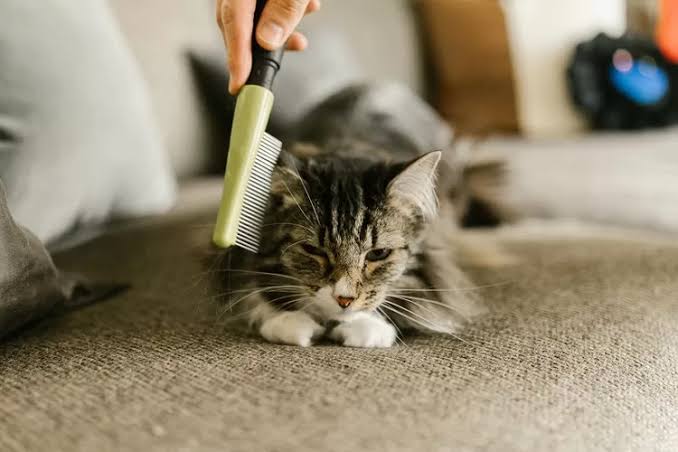Feline Hair Loss can be a frightening thing to see in your furry little buddy. There are many different causes of hair loss in cats, some are worth worrying over while others just call for a diet adjustment. Regardless of the reason for hair loss, it is your job as a cat owner to take the necessary steps to avoid further discomfort for your cat.
An Ounce of Prevention
Many variables can cause hair loss in cats. The best way to avoid hair loss caused by allergies and a poor diet is to feed your cat healthy food from the onset.
Diet
Choose a food high in protein where the first ingredient is meat, preferably salmon or turkey. Other meats, such as beef or even chicken, may not provide your cat with all the necessary nutrients. The best foods will have the most digestible ingredients for maintaining cat health.
Turkey and salmon are both considered meats a cat would eat without human intervention, and both offer the most digestible proteins for felines. Some veterinarians warn that fish-based foods can lead to hyperthyroidism; however, this is generally only the case with very low-end foods. To avoid this disorder, augment your cat’s diet with a Vitamin E and Vitamin B supplement.
Environment
If you allow your cats to enjoy the outdoors, be sure they are up to date with all vaccinations. Not only will this keep them from experiencing any preventable illnesses that could cause hair loss, vaccinations will also stave off much more serious and possibly fatal diseases.
For your outdoor cat, use a preventative treatment that protects against all critters that can cause feline hair loss and other serious problems, including fleas, mites, heartworms, ringworms, and ticks. Be sure that any preventative you use is specifically formulated for cats.
Some Causes of Feline Hair Loss
Hair loss in cats is generally caused by one of the following disorders.
Hyperthyroidism
As the most common disorder that felines experience, hyperthyroidism is also the leading cause of cat hair loss. Other symptoms of hyperthyroidism include weight loss, a curb or complete standstill in grooming, excessive thirst and urination, and insatiable appetite. Luckily, in most cases, hyperthyroidism can be easily controlled with medication or radioactive iodine therapy.
Fleas
If a flea infestation is bad enough or your cat has particularly sensitive skin, hair loss may occur. Itching skin that is hard to reach through dander and fur becomes your cat’s only focus. To stop the itching, Fluffy will go to any lengths, including biting off hair in the bothersome area to get to the agitated skin. cats with fleas should be treated immediately to avoid further more serious complications to their overall health.
Allergies
Hair loss and itching are common symptoms when a cat has an allergic reaction to something it has either eaten or come into contact with in the environment. Tracking down the cause of the allergy is the most difficult part of diagnosing the problem. Once the allergen has been identified, treatment usually involves eliminating the substance from the cat’s diet or environment. As the allergen works its way out of a cat’s system, itchy rashes begin to fade away. A vet may also prescribe medication to temporarily relieve the worst of the itching. Once the system returns to normal, most cats will regrow their fur.
Pyoderma
Pyoderma is a bacterial infection that commonly sets in when the skin is traumatized from scratching and biting. The infection produces localized hair loss as well as a puss discharge that crusts over the lesions. Great care must be taken to clean away the discharge to promote healing, but since pyoderma is a secondary infection, it’s still crucial to determine the cause of the irritation.
Mange
Mange mites burrow under the skin and can cause extreme itching even though they can’t be seen. Mange is typically diagnosed via skin scrapings viewed under a microscope. Treatment usually involves the application of a pyrethrin product under veterinary supervision.
Ringworm
Ringworm is a fungal infection that produces circular patches of hair loss as the fungus infests the hair shafts. It is generally treated with various dips or oral medications, but some vets also recommend shaving the infected cat to completely remove the fungus. Once the fungus is gone, the hair should regrow.
Notoedres Cati
In some cases, cat hair loss can be brought on by other lesser-known causes, such as noodles cati. This is a parasite that causes alopecia in cats. Hair loss from noodles cats is seen on the ears, neck, eyelids, and other facial and upper body regions. While most people have never heard of noodles cati, it is the second most common parasite in cats.
Cushing’s Disease
Cushing’s disease, also known as hyperadrenocorticism, is a far less common cause of cat hair loss. Other symptoms that will occur concomitantly are an increased appetite and thirst as well as mild to severe lethargy. You may notice that your cat’s skin seems thin, or the petting your cat once enjoyed may now agitate it. The hair loss associated with Cushing’s disease is bilateral, meaning what is missing on one side of the animal’s body will be almost the same as what is missing on the other. Generally, this hair loss is located on the mid to lower abdomen, but it can technically occur anywhere on the body.
Words of Advice
If your cat displays any of the symptoms discussed in this article, ask your vet to thoroughly examine your cat to get a proper diagnosis and treatment plan. Remember, your cat’s fur protects its skin, so fur loss can become a serious problem if left untreated.

